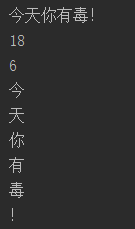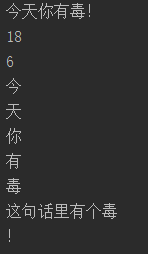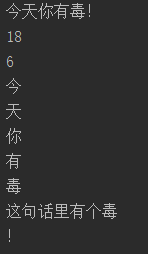python--汉字字符处理
一、输出一串汉字字符串
#-*—coding:utf8-*-
def txt_test():
string = u'今天你有毒!'
print string
txt_test()二、输出字符串长度
#-*—coding:utf8-*-
def txt_test():
string = '今天你有毒!'
print string
print len(string)
txt_test()输出: 18–与汉字的长度不符。
三、解码成UTF-8格式并测量长度
方法一:
#-*—coding:utf8-*-
def txt_test():
string = u'今天你有毒!'
print string
print len(string)
txt_test()方法二:
#-*—coding:utf8-*-
def txt_test():
string = '今天你有毒!'
print string
print len(string)
print len(string.decode('utf-8'))
txt_test()输出:6–和汉字实际的长度一致。
四、把汉字字符串一个汉字一个汉字的输出
方法一:
#-*—coding:utf8-*-
def txt_test():
string = u'今天你有毒!'
print string
print len(string)
print len(string)
for i in range(0,len(string),1):
print string[i]
txt_test()方法二:
#-*—coding:utf8-*-
def txt_test():
string = '今天你有毒!'
print string
print len(string)
print len(string.decode('utf-8'))
for i in range(0,len(string.decode('utf-8')),1):
print string.decode('utf-8')[i]
txt_test()输出:
方法二:
五、判断汉字字符串里面是否有某个汉字
方法一:
#-*—coding:utf8-*-
def txt_test():
string = u'今天你有毒!'
print string
print len(string)
print len(string)
for i in range(0,len(string),1):
print string[i]
if string[i] == u'毒':
print u'这句话里有个毒'
txt_test()方法二:
#-*—coding:utf8-*-
def txt_test():
string = '今天你有毒!'
print string
print len(string)
print len(string.decode('utf-8'))
for i in range(0,len(string.decode('utf-8')),1):
print string.decode('utf-8')[i]
if string.decode('utf-8')[i] == u'毒':
print '这句话里有个毒'
txt_test()




